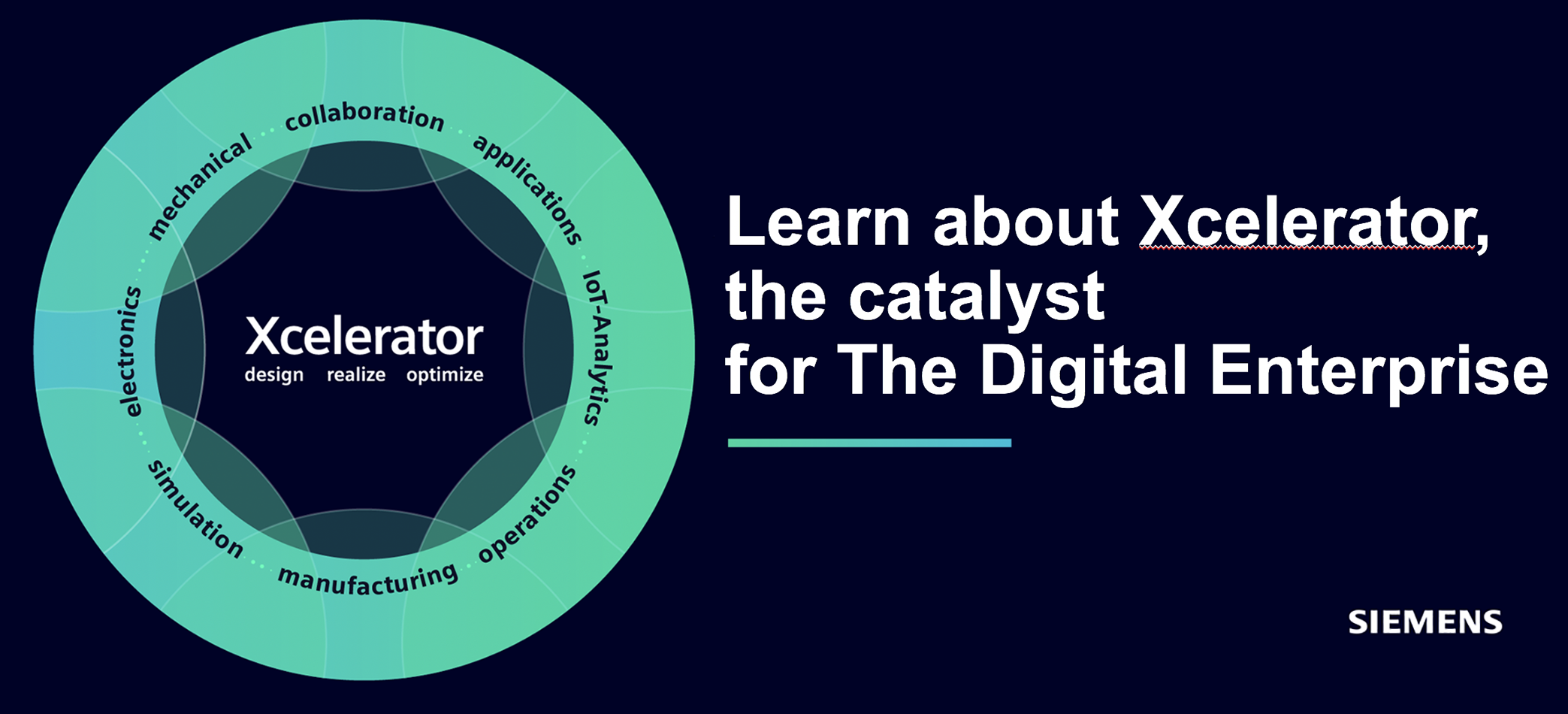Analyst Positions Siemens NX and Solid Edge as “the Market’s Most Innovative CAD Solutions”
…but Autodesk’s AutoCAD, Inventor and Fusion Lead the Growth Index. There is no doubt that the fight for leadership positions in the CAD area today, more than ever, is the battle between the four major PLM and CAD developers. We are talking about Dassault Systemes’ CATIA/SOLIDWORKS, Siemens Digital Industries Software’s NX CAD/Solid Edge, PTC’s Creo/Onshape and Autodesk’s AutoCAD, Inventor and Fusion. But who has the lead in the race to the future?
The question is not entirely easy to answer and depends largely on who you ask, what the platform will be used for, and what perspective you take in everything from market share/license size and high-end or mainstream to development direction and technical platform. In today's article, we will take a closer look at what two analysts have come up with in their evaluations of Siemens NX and Solid Edge (SE):
• First, the analyst Frost & Sullivan, who recently published an evaluation, "Frost Radar: Mechanical Computer-aided Design, 2025"
• Second, the PLM specialist CIMdata, who in a commentary has focused on NX-X and a mixed SaaS and cloud angle, "Siemens NX-X: SaaS-Based MCAD (Commentary)."
Generally, NX CAD is particularly strong in the automotive, aerospace & defense, machine design and medical technology markets. In terms of development, the approach is strategically more evolutionary than revolutionary, i.e. they work with continuous development to secure their leading position, rather than revolutionaryly turning existing processes and expertise of their customers upside down.
In terms of purpose, NX is used for, among other things, all types of design (parametric and direct solid/surface modeling), technical analysis (static; dynamic; electromagnetic; thermal and fluid). Both the high-end solution NX and its mainstream counterpart, Solid Edge, are available as SaaS and cloud solutions, with the suffix “X”.
Well known strengths in Siemens environments include openness and integration with other parts of the market’s perhaps richest software portfolio, Xcelerator; combined with connections to the manufacturing side and smart factory automation.
Examples of software in the Xcelerator suite are Teamcenter (PLM), Simcenter platform (Simulation & Analysis), Polarion (ALM, “software management”), Siemens EDA (electronic design), Opcenter (OT, “shopfloor automation”), Mendix (low/no-code platform) and more.
So, how do the NX/SE solutions stack up? In a graphic illustration built as a circle with four pie slices and with a vertical axis that positions the solutions partly in a “growth index” and partly a horizontal axis for the “innovation index”, Siemens reaches the top position for the innovative part, while it ends up slightly lower on the “growth axis”, where Autodesk’s three software solutions top.
Frost Radar’s evaluation states, among other things, that Siemens NX/Solid Edge has achieved the top rating in the innovation index and performed well in the growth index. Some of the company’s unique features include, “the many add-ons that are available to extend the capabilities of NX; the flexibility of licensing and Siemens electronics design strength, enabling seamless MCAD-ECAD collaboration.”
While analyst CIMdata, regarding NX-X, emphasizes that, “through its DesignCenter, Siemens delivers complete, transparent compatibility across its MCAD solutions – the data models are identical across NX, NX-X and Solid Edge/SE X – no data migrations, updates or translations are required.” “Take a look at NX-X,” recommends CIMdata – why?
Click on the headline to read the full article on PLM&ERP News.
The question is not entirely easy to answer and depends largely on who you ask, what the platform will be used for, and what perspective you take in everything from market share/license size and high-end or mainstream to development direction and technical platform. In today's article, we will take a closer look at what two analysts have come up with in their evaluations of Siemens NX and Solid Edge (SE):
• First, the analyst Frost & Sullivan, who recently published an evaluation, "Frost Radar: Mechanical Computer-aided Design, 2025"
• Second, the PLM specialist CIMdata, who in a commentary has focused on NX-X and a mixed SaaS and cloud angle, "Siemens NX-X: SaaS-Based MCAD (Commentary)."
Generally, NX CAD is particularly strong in the automotive, aerospace & defense, machine design and medical technology markets. In terms of development, the approach is strategically more evolutionary than revolutionary, i.e. they work with continuous development to secure their leading position, rather than revolutionaryly turning existing processes and expertise of their customers upside down.
In terms of purpose, NX is used for, among other things, all types of design (parametric and direct solid/surface modeling), technical analysis (static; dynamic; electromagnetic; thermal and fluid). Both the high-end solution NX and its mainstream counterpart, Solid Edge, are available as SaaS and cloud solutions, with the suffix “X”.
Well known strengths in Siemens environments include openness and integration with other parts of the market’s perhaps richest software portfolio, Xcelerator; combined with connections to the manufacturing side and smart factory automation.
Examples of software in the Xcelerator suite are Teamcenter (PLM), Simcenter platform (Simulation & Analysis), Polarion (ALM, “software management”), Siemens EDA (electronic design), Opcenter (OT, “shopfloor automation”), Mendix (low/no-code platform) and more.
So, how do the NX/SE solutions stack up? In a graphic illustration built as a circle with four pie slices and with a vertical axis that positions the solutions partly in a “growth index” and partly a horizontal axis for the “innovation index”, Siemens reaches the top position for the innovative part, while it ends up slightly lower on the “growth axis”, where Autodesk’s three software solutions top.
Frost Radar’s evaluation states, among other things, that Siemens NX/Solid Edge has achieved the top rating in the innovation index and performed well in the growth index. Some of the company’s unique features include, “the many add-ons that are available to extend the capabilities of NX; the flexibility of licensing and Siemens electronics design strength, enabling seamless MCAD-ECAD collaboration.”
While analyst CIMdata, regarding NX-X, emphasizes that, “through its DesignCenter, Siemens delivers complete, transparent compatibility across its MCAD solutions – the data models are identical across NX, NX-X and Solid Edge/SE X – no data migrations, updates or translations are required.” “Take a look at NX-X,” recommends CIMdata – why?
Click on the headline to read the full article on PLM&ERP News.
Siemens NX och Solid Edge positioneras som ”CAD-marknadens mest innovativa”, i färsk analytiker-utvärdering
...men Autodesks lösningar AutoCAD, Inventor och Fusion-plattformen har högsta tillväxten. Att kampen om ledarpositionerna på CAD-området idag mer än någonsin står mellan de fyra stora PLM- och CAD-utvecklarna behöver ingen tvivla över. Vi talar alltså om Dassault Systemes CATIA/SOLIDWORKS, Siemens Digital Industries Softwares NX CAD/Solid Edge, PTCs Creo/Onshape och Autodesks AutoCAD, Inventor- och Fusion. Men vem har ledningen i racet in mot framtiden?
Svaret beror förstås i hög grad på vem man frågar, vad plattformen ska användas till, och vilket perspektiv man anlägger: allt ifrån marknadsandelar/licensstorlek och high-end eller mainstream till utvecklingsinriktning och teknisk plattform. I dagens artikel ska vi titta lite närmare på vad några välrenommerade analytiker kommit fram till i utvärderingar av Siemens NX och Solid Edge (SE):
• Dels analytikern Frost & Sullivan, som nyligen publicerat en utvärdering, ”Frost Radar: Mechanical Computer-aided Design, 2025”
• Dels PLM-specialisten CIMdata, som i en kommentar har fokuserat på NX X och en blandad SaaS- och molnvinkel, ”Siemens NX X: SaaS-Based MCAD (Commentary).”
Allmänt är NX CAD marknadsmässigt särskilt stark inom automotive, aerospace & defense, maskindesign och medicinteknik. Utvecklingsmässigt är anslaget strategiskt mer evolutionärt än revolutionärt, d v s man jobbar med kontinuerlig utveckling för att säkerställa sin ledande position, snarare än att revolutionärt vända upp och ner på existerande processer och kunnande hos sina kunder. Användningsmässigt utnyttjas NX för bl a alla typer av design (parametrisk och direkt solid/ytmodellering), teknisk analys (statisk; dynamisk; elektromagnetisk; termisk och fluid). Både high-end-lösningen NX och mainstream-motsvarigheten, Solid Edge, finns som SaaS- och molnlösningar, då med suffixet ”X”. Välbekanta styrkor i Siemens-miljöerna är sånt som öppenheten och integrationen med övriga delar i marknadens kanske rikaste program-portfölj, Xcelerator; kombinerat med kopplingarna till tillverkningssidan och smart fabriksautomation.
Så, hur står sig lösningarna? I en grafisk illustration byggd som en cirkel med fyra tårtbitar och med en lodrät axel som positionerar lösningarna dels i ett ”tillväxt-index” och dels en vågrät axel för ”innovations-index”, når Siemens topposition för den innovativa biten, medan man hamnar något lägre på ”tillväxt-axeln”, där Autodesks mjukvaror hamnar i topp. Detta emedan CIMdata när det gäller NX-X framhåller att, ”genom sitt DesignCenter levererar Siemens fullständig, transparent kompatibilitet över sina MCAD-lösningar – datamodellerna är identiska bland NX, NX-X och Solid Edge/SE X – inga datamigreringar, uppdateringar eller translationer behövs.”
”Ta en titt på NX-X,” rekommenderar CIMdata – varför?
Klicka på rubriken för att läsa mer på PLM&ERP News.
Svaret beror förstås i hög grad på vem man frågar, vad plattformen ska användas till, och vilket perspektiv man anlägger: allt ifrån marknadsandelar/licensstorlek och high-end eller mainstream till utvecklingsinriktning och teknisk plattform. I dagens artikel ska vi titta lite närmare på vad några välrenommerade analytiker kommit fram till i utvärderingar av Siemens NX och Solid Edge (SE):
• Dels analytikern Frost & Sullivan, som nyligen publicerat en utvärdering, ”Frost Radar: Mechanical Computer-aided Design, 2025”
• Dels PLM-specialisten CIMdata, som i en kommentar har fokuserat på NX X och en blandad SaaS- och molnvinkel, ”Siemens NX X: SaaS-Based MCAD (Commentary).”
Allmänt är NX CAD marknadsmässigt särskilt stark inom automotive, aerospace & defense, maskindesign och medicinteknik. Utvecklingsmässigt är anslaget strategiskt mer evolutionärt än revolutionärt, d v s man jobbar med kontinuerlig utveckling för att säkerställa sin ledande position, snarare än att revolutionärt vända upp och ner på existerande processer och kunnande hos sina kunder. Användningsmässigt utnyttjas NX för bl a alla typer av design (parametrisk och direkt solid/ytmodellering), teknisk analys (statisk; dynamisk; elektromagnetisk; termisk och fluid). Både high-end-lösningen NX och mainstream-motsvarigheten, Solid Edge, finns som SaaS- och molnlösningar, då med suffixet ”X”. Välbekanta styrkor i Siemens-miljöerna är sånt som öppenheten och integrationen med övriga delar i marknadens kanske rikaste program-portfölj, Xcelerator; kombinerat med kopplingarna till tillverkningssidan och smart fabriksautomation.
Så, hur står sig lösningarna? I en grafisk illustration byggd som en cirkel med fyra tårtbitar och med en lodrät axel som positionerar lösningarna dels i ett ”tillväxt-index” och dels en vågrät axel för ”innovations-index”, når Siemens topposition för den innovativa biten, medan man hamnar något lägre på ”tillväxt-axeln”, där Autodesks mjukvaror hamnar i topp. Detta emedan CIMdata när det gäller NX-X framhåller att, ”genom sitt DesignCenter levererar Siemens fullständig, transparent kompatibilitet över sina MCAD-lösningar – datamodellerna är identiska bland NX, NX-X och Solid Edge/SE X – inga datamigreringar, uppdateringar eller translationer behövs.”
”Ta en titt på NX-X,” rekommenderar CIMdata – varför?
Klicka på rubriken för att läsa mer på PLM&ERP News.
ALTAIR tar realtidshantering av digitala tvillingar tillen ny nivå med NVIDIAs teknik för GPU-acceleration
CAE: Om den SÖMLÖSA INTEGRATIONEN mellan Altair One Cloud Innovation Gateway och NVIDIA Omniverse Blueprint. Få tvivlar idag på värdet som kommer med GPU-accelererad innovation i simuleringsdrivet designarbete. Ytterst är kapaciteten att bearbeta stora datamängder avgörande för hastighet, kapacitet och kvalitet i simulering. En utveckling som inte minst tagit explosiv fart i ljuset av de senaste årens boom för NVIDIAs Omniverse; dels bland PLM-utvecklare, dels på användarsidan bland större OEM-företag. I det senare fallet är exempelvis fordonsindustrin, som alltid, snabb på att implementera lösningar i praktiska koncept. Mercedes och BMW är exempel på företag som har satt NVIDIA-lösningar i framkant i samband med nya produktRrealiserings- och fabrikskoncept.
Altair är alltså en av spelarna på PLM-utvecklingssidan som har anammat NVIDIAs lösningar för GPU-acceleration – NVIDIA NIM-mikrotjänster och NVIDIA Omniverse-teknologier. Denna HPC (High Performance Computing), AI, simulerings- och analysutvecklare, som kommer att ägas av SIEMENS Digital Industries Software när alla formaliteter är klara, tillkännagav denna vecka en teknisk integration mellan NVIDIA Omniverse Blueprint for Real Time Digital Twins och Altair Ones gateway för molninnovation.
Detta, menar Altairs CTO, Sam Mahalingam, kommer att hjälpa användare att ta ytterligare steg framåt i sina digitala transformations-satsningar. De potentiella tidsbesparingarna är signifikanta; med modeller i verktyg som Altair PhysicsAI kan analystiden tar GPU-acceleration för exempelvis reduceras från timmar eller dagar till sekunder eller minuter.
"Att integrera Omniverse Blueprint för digitala tvillingar i realtid med Altair One ger användarna ett kraftfullt nytt sätt att operera och förnya sig med digitala tvillingar, data och AI i realtid. Det är också ytterligare ett exempel på hur Altair fortsätter att vara ledande inom allt som rör digital ingenjörskonst och digital tvilling", sa han i ett uttalande.
I ett pressmeddelande hävdar Altair att användare genom att utnyttja NVIDIA Omniverse Blueprint för digitala tvillingar i Altair One i realtid kan samarbeta och simulera i en delad virtuell miljö. Tekniken kombinerar 3D-design, AI och ray tracing för att skapa immersiva digitala miljöer, som fungerar som en digital arbetsplats på nästa nivå för yrkesverksamma inom olika branscher. Användare kan i detta dra nytta av avancerade renderings- och strömningsmöjligheter i molnet, som förenklar hur programvaru-komponenter fungerar tillsammans i stora system, särskilt de som används för AI, databehandling och grafisk datoranvändning. Integrationen kommer att öppna upp nya vägar för innovation och samarbete inom områden som krasch- och falltestsimuleringar.
"Digital tvillingteknologi omformar idag industrier och ger ingenjörer och designers verktygen för att möjliggöra realtidsdesign, optimera snabbare och annat", säger Timothy Costa, senior chef för CAE och CUDA-X på NVIDIA. "Nu kan Altair-användare utnyttja NVIDIA-klassens bästa teknik för att effektivisera sina digitala arbetsflöden."
Det ska onekligen bli intressant att se vad Siemens och Altair kan göra tillsammans kring simuleringsdrivna digitala tvillingar i NVIDIAs GPU-accelererade miljöer.
Klicka på rubriken för att läsas mer på PLM&ERP News.
Altair är alltså en av spelarna på PLM-utvecklingssidan som har anammat NVIDIAs lösningar för GPU-acceleration – NVIDIA NIM-mikrotjänster och NVIDIA Omniverse-teknologier. Denna HPC (High Performance Computing), AI, simulerings- och analysutvecklare, som kommer att ägas av SIEMENS Digital Industries Software när alla formaliteter är klara, tillkännagav denna vecka en teknisk integration mellan NVIDIA Omniverse Blueprint for Real Time Digital Twins och Altair Ones gateway för molninnovation.
Detta, menar Altairs CTO, Sam Mahalingam, kommer att hjälpa användare att ta ytterligare steg framåt i sina digitala transformations-satsningar. De potentiella tidsbesparingarna är signifikanta; med modeller i verktyg som Altair PhysicsAI kan analystiden tar GPU-acceleration för exempelvis reduceras från timmar eller dagar till sekunder eller minuter.
"Att integrera Omniverse Blueprint för digitala tvillingar i realtid med Altair One ger användarna ett kraftfullt nytt sätt att operera och förnya sig med digitala tvillingar, data och AI i realtid. Det är också ytterligare ett exempel på hur Altair fortsätter att vara ledande inom allt som rör digital ingenjörskonst och digital tvilling", sa han i ett uttalande.
I ett pressmeddelande hävdar Altair att användare genom att utnyttja NVIDIA Omniverse Blueprint för digitala tvillingar i Altair One i realtid kan samarbeta och simulera i en delad virtuell miljö. Tekniken kombinerar 3D-design, AI och ray tracing för att skapa immersiva digitala miljöer, som fungerar som en digital arbetsplats på nästa nivå för yrkesverksamma inom olika branscher. Användare kan i detta dra nytta av avancerade renderings- och strömningsmöjligheter i molnet, som förenklar hur programvaru-komponenter fungerar tillsammans i stora system, särskilt de som används för AI, databehandling och grafisk datoranvändning. Integrationen kommer att öppna upp nya vägar för innovation och samarbete inom områden som krasch- och falltestsimuleringar.
"Digital tvillingteknologi omformar idag industrier och ger ingenjörer och designers verktygen för att möjliggöra realtidsdesign, optimera snabbare och annat", säger Timothy Costa, senior chef för CAE och CUDA-X på NVIDIA. "Nu kan Altair-användare utnyttja NVIDIA-klassens bästa teknik för att effektivisera sina digitala arbetsflöden."
Det ska onekligen bli intressant att se vad Siemens och Altair kan göra tillsammans kring simuleringsdrivna digitala tvillingar i NVIDIAs GPU-accelererade miljöer.
Klicka på rubriken för att läsas mer på PLM&ERP News.
Altair Takes GPU Acceleration over a Tipping Point for Real-Time Digital Twins with NVIDIA...
On the SEAMLESS INTEGRATION between Altair One Cloud Innovation Gateway and NVIDIA Omniverse Blueprint. Few today doubt the value that comes with GPU-accelerated innovation in simulation-driven design work. Ultimately, the capacity to process heavy data volumes is critical to speed, capability and quality in simulation. A development that has not least gained explosive momentum in the light of the NVIDIA boom of recent years; partly among PLM developers, and partly on the user side among larger OEM companies. In the latter case, for example, the automotive industry as always is quick to implement solutions in practical concepts. Mercedes and BMW are examples of companies that have put NVIDIA solutions at the forefront in connection with new product realization and factory concepts.
Altair is one of the players on the PLM and sub-PLM development side that has embraced NVIDIA's solutions for GPU acceleration–NVIDIA NIM microservices, and NVIDIA Omniverse technologies. This HPC (High Performance Computing), AI, simulation and analysis developer, which will be owned by SIEMENS Digital Industries Software once all formalities are complete, announced this week a technical integration between the NVIDIA Omniverse Blueprint for Real Time Digital Twins and the Altair One cloud innovation gateway. This, Altair’s Chief Technology Officer Sam Mahalingam believes, will help users take another step forward in their digital engineering and digital transformation efforts. The potential time savings are huge: with models in tools like Altair PhysicsAI, analysis time can be reduced from hours or days to seconds or minutes.
“Integrating the Omniverse Blueprint for Real Time Digital Twins with Altair One gives users a powerful new way to operationalize and innovate with digital twins, data and AI in real time. It’s also another example of how Altair continues to be a leader in all things digital engineering and digital twin,” he said in a statement.
In the press release, Altair claims that by leveraging NVIDIA Omniverse Blueprint for real-time digital twins in Altair One, users can collaborate and simulate in a shared virtual environment in real time. The technology combines 3D design, AI, and ray tracing to create immersive digital environments that serve as a next-level digital workplace for professionals across industries. Users benefit from advanced rendering and streaming capabilities in the cloud that simplify how software components work together in large systems, especially those used for AI, data processing, and graphics computing. The integration will open up new avenues for innovation and collaboration in areas such as crash and drop test simulations.
"Digital twin technology is reshaping industries and giving engineers and designers the tools to enable real-time design, optimize faster, and do more," said Timothy Costa, senior director of CAE and CUDA-X at NVIDIA. “Now, Altair users can leverage NVIDIA’s best-in-class technology to operationalize digital engineering and streamline their digital workflows.”
It will be incredibly interesting to see what Siemens and Altair can do together around simulation-driven digital twins in NVIDIA’s GPU accelerated environments. It can take the practical use over a tipping point.
Click on the headline to read more on PLM&ERP News.
Altair is one of the players on the PLM and sub-PLM development side that has embraced NVIDIA's solutions for GPU acceleration–NVIDIA NIM microservices, and NVIDIA Omniverse technologies. This HPC (High Performance Computing), AI, simulation and analysis developer, which will be owned by SIEMENS Digital Industries Software once all formalities are complete, announced this week a technical integration between the NVIDIA Omniverse Blueprint for Real Time Digital Twins and the Altair One cloud innovation gateway. This, Altair’s Chief Technology Officer Sam Mahalingam believes, will help users take another step forward in their digital engineering and digital transformation efforts. The potential time savings are huge: with models in tools like Altair PhysicsAI, analysis time can be reduced from hours or days to seconds or minutes.
“Integrating the Omniverse Blueprint for Real Time Digital Twins with Altair One gives users a powerful new way to operationalize and innovate with digital twins, data and AI in real time. It’s also another example of how Altair continues to be a leader in all things digital engineering and digital twin,” he said in a statement.
In the press release, Altair claims that by leveraging NVIDIA Omniverse Blueprint for real-time digital twins in Altair One, users can collaborate and simulate in a shared virtual environment in real time. The technology combines 3D design, AI, and ray tracing to create immersive digital environments that serve as a next-level digital workplace for professionals across industries. Users benefit from advanced rendering and streaming capabilities in the cloud that simplify how software components work together in large systems, especially those used for AI, data processing, and graphics computing. The integration will open up new avenues for innovation and collaboration in areas such as crash and drop test simulations.
"Digital twin technology is reshaping industries and giving engineers and designers the tools to enable real-time design, optimize faster, and do more," said Timothy Costa, senior director of CAE and CUDA-X at NVIDIA. “Now, Altair users can leverage NVIDIA’s best-in-class technology to operationalize digital engineering and streamline their digital workflows.”
It will be incredibly interesting to see what Siemens and Altair can do together around simulation-driven digital twins in NVIDIA’s GPU accelerated environments. It can take the practical use over a tipping point.
Click on the headline to read more on PLM&ERP News.
Why Axiom Space Bets on Siemens’ Xcelerator Portfolio to Develop Next-Generation Space Station
“A MODEL for how the space industry can ACCELERATE DEVELOPMENT through CROSS-SECTOR COLLABORATION." As the International Space Station, ISS, is approaching the final phase of its life, one of the questions is: what comes after? It’s clear that the world will need a new modern equivalent. In this, American Axiom Space, founded in 2016, plays an interesting role. Axion Space is one of the companies that like SpaceX has launched private initiatives around space travel and related technology in everything from spacesuits to infrastructure over the past decade. The company has been involved in several ISS missions, including to support expanded use of the space station, while currently working intensively to create the first international commercial space station. It has a contract with the American space agency, NASA, to develop at least one habitable commercial module to be connected to the ISS station. But the goal is for this to become a free-flying destination in low Earth orbit before the orbiting laboratory retires in 2030.
Today's news is that the company has chosen to bet on Siemens Digital Industries Software's PLM portfolio, Xcelerator, to sharpen the support needed for effective development work.
"Yes, we chose this solution after an extensive selection process. The Xcelerator portfolio allows us to refine our workflows and simplify complex processes, connecting the dots between the design, manufacturing, analysis and operations phases," says Dave Romero, who is Station Program Manager at Axiom Space. "With the help of these software, we can test and simulate our designs before we build them, which allows us to develop with more agility and increased flexibility."
Thereby, Axiom also follows closely in the footsteps of rocket manufacturer SpaceX, which works with all Siemens heavy PLM solutions, including NX CAD (also NX Nastran), Femap (advanced FEM) and Teamcenter as cPDm backbone. In fact SpaceX has modeled the entire Falcon 1 and Falcon 9 rockets and the Dragon capsule in NX.
What particularly appealed to Axiom Space was Siemens’ concept of digital threads and digital twins, which can be created on a single platform where all phases of program development are integrated.
Not least the latter is important, says Siemens VP for Aerospace & Defense Industry, Todd Tuthill:
"With the power of our digital transformation concept, people and assets across the company are being engaged in 'orbit' faster and at lower cost," he says.
Click on the headline to read more on PLM&ERP News.
Today's news is that the company has chosen to bet on Siemens Digital Industries Software's PLM portfolio, Xcelerator, to sharpen the support needed for effective development work.
"Yes, we chose this solution after an extensive selection process. The Xcelerator portfolio allows us to refine our workflows and simplify complex processes, connecting the dots between the design, manufacturing, analysis and operations phases," says Dave Romero, who is Station Program Manager at Axiom Space. "With the help of these software, we can test and simulate our designs before we build them, which allows us to develop with more agility and increased flexibility."
Thereby, Axiom also follows closely in the footsteps of rocket manufacturer SpaceX, which works with all Siemens heavy PLM solutions, including NX CAD (also NX Nastran), Femap (advanced FEM) and Teamcenter as cPDm backbone. In fact SpaceX has modeled the entire Falcon 1 and Falcon 9 rockets and the Dragon capsule in NX.
What particularly appealed to Axiom Space was Siemens’ concept of digital threads and digital twins, which can be created on a single platform where all phases of program development are integrated.
Not least the latter is important, says Siemens VP for Aerospace & Defense Industry, Todd Tuthill:
"With the power of our digital transformation concept, people and assets across the company are being engaged in 'orbit' faster and at lower cost," he says.
Click on the headline to read more on PLM&ERP News.
Därför satsar Axiom Space på Siemens Xcelerator i utvecklingen av nästa generations rymdstation
”FÖRENKLAR KOMPLEXA PROCESSER och kopplar ihop design, analys, tillverkning och drift.” När den internationella rymdstationen, ISS, nu går mot slutfasen av sitt liv är en av frågorna: vad kommer efteråt? Klart är att världen kommer att behöva en ny modern motsvarighet. I detta spelar amerikanska Axiom Space, grundat 2016, en intressant roll. Axion Space är ett av de företag som under det senaste decenniet lanserat privata intitiativ kring rymdfärder och relaterad teknologi i allt ifrån rymddräkter till infrastruktur. Bolaget har i detta varit involverat i en rad ISS-uppdrag bland annat för att stödja utökad användning av rymdstationen, samtidigt som man idag jobbar intensivt med att skapa den första internationella kommersiella rymdstationen. Man har kontrakt med amerikanska rymdstyrelsen, NASA, kring utvecklingen av minst en beboelig kommersiell modul som ska kopplas till ISS-stationen. Men målet är att denna ska bli en friflygande destination i låg omloppsbana runt jorden innan det kretsande laboratoriet går i pension 2030.
Dagens nyhet är att bolaget valt att satsa på Siemens Digital Industries Softwares PLM-portfölj, Xcelerator, för att vässa stödet som behövs för ett effektivt utvecklingsarbete. Mjukvaran på denna plattform, menar man, kommer att hjälpa Axiom Space att optimera det kritiska arbetet med nästa generations kommersiella rymdstationer och rymddräktsprogram.
"Ja, vi valde denna lösning efter en omfattande urvalsprocess. Xcelerator-portföljen gör det möjligt för oss att förfina våra arbetsflöden och förenkla komplexa processer, och koppla ihop punkterna mellan design-, tillverknings-, analys- och driftsfaser", säger Dave Romero, som är Station Program Manager på Axiom Space. "Med hjälp av dessa mjukvaror kan vi testa och simulera våra konstruktioner innan vi bygger dem, vilket gör att vi kan utvecklas med mer smidighet och ökad flexibilitet."
Vad som särskilt tilltalat Axiom Space är Siemens koncept kring digitala trådar och digitala tvillingar, som kan skapas på en enda plattform där alla faser i programutvecklingen finns integrerade.
"Samarbetet mellan oss och Siemens är en modell för hur rymdindustrin kan accelerera genom tvärsektoriellt samarbete", konstaterae Tejpaul Bhatia, Axiom Space Chief Revenue Officer. "Förra året skrev vi ett avtal med Bayerns delstatskansli för att främja rymdindustrin tillsammans. Vårt samarbete med Siemens för att förbättra Axiom Station och rymddräkts-utvecklingen i Europa exemplifierar hur utnyttjande av avancerade mjukvarulösningar kan driva innovation och operativ excellens. Det stärker också vår förmåga, samtidigt som det understryker vårt engagemang för att främja hållbar tillgång till rymden och stödja en global rymdekonomi."
Inte minst det senare är viktigt, menar Siemens VP för Aerospace & Defense Industry, Todd Tuthill:
”Precis, med kraften i vårt digitala transformationskoncept, engageras människor och tillgångar över hela företaget i ’omloppsbana’ snabbare och till lägre kostnad."
Klicka på rubriken för att läsa mer på PLM&ERP News.
Dagens nyhet är att bolaget valt att satsa på Siemens Digital Industries Softwares PLM-portfölj, Xcelerator, för att vässa stödet som behövs för ett effektivt utvecklingsarbete. Mjukvaran på denna plattform, menar man, kommer att hjälpa Axiom Space att optimera det kritiska arbetet med nästa generations kommersiella rymdstationer och rymddräktsprogram.
"Ja, vi valde denna lösning efter en omfattande urvalsprocess. Xcelerator-portföljen gör det möjligt för oss att förfina våra arbetsflöden och förenkla komplexa processer, och koppla ihop punkterna mellan design-, tillverknings-, analys- och driftsfaser", säger Dave Romero, som är Station Program Manager på Axiom Space. "Med hjälp av dessa mjukvaror kan vi testa och simulera våra konstruktioner innan vi bygger dem, vilket gör att vi kan utvecklas med mer smidighet och ökad flexibilitet."
Vad som särskilt tilltalat Axiom Space är Siemens koncept kring digitala trådar och digitala tvillingar, som kan skapas på en enda plattform där alla faser i programutvecklingen finns integrerade.
"Samarbetet mellan oss och Siemens är en modell för hur rymdindustrin kan accelerera genom tvärsektoriellt samarbete", konstaterae Tejpaul Bhatia, Axiom Space Chief Revenue Officer. "Förra året skrev vi ett avtal med Bayerns delstatskansli för att främja rymdindustrin tillsammans. Vårt samarbete med Siemens för att förbättra Axiom Station och rymddräkts-utvecklingen i Europa exemplifierar hur utnyttjande av avancerade mjukvarulösningar kan driva innovation och operativ excellens. Det stärker också vår förmåga, samtidigt som det understryker vårt engagemang för att främja hållbar tillgång till rymden och stödja en global rymdekonomi."
Inte minst det senare är viktigt, menar Siemens VP för Aerospace & Defense Industry, Todd Tuthill:
”Precis, med kraften i vårt digitala transformationskoncept, engageras människor och tillgångar över hela företaget i ’omloppsbana’ snabbare och till lägre kostnad."
Klicka på rubriken för att läsa mer på PLM&ERP News.
”Hållbarhet är lönsamt,” menar 75 procent av svenska tillverkare enligt färsk rapport
Molnbaserad ERP kan öppna dörren för hållbarhet genom stöd för avancerad teknologi som AI och IoT.
Hur står sig hållbarhetsarbetet i perspektivet av lönsamhet för den svenska tillverkningsindustrin? Affärssystemutvecklaren Jeeves Forterro har tittat på saken i en ny studie som visar att 72 % av svenska medelstora tillverkare har rapporterat ökad lönsamhet tack vare en mer hållbar verksamhet.
Undersökningen visar också i vilken utsträckning svenska tillverkare nu fokuserar på hållbarhet. I detta säger 76 % av respondenterna att det är en prioritet. 78 % uppger att deras organisation har en dedikerad resurs för att hantera hållbarhet, medan 69 % pekar på att deras organisation har en Net Zero-plan.
”Alla tillverkare i Sverige är medvetna om de utmaningar som följer med att arbeta mer hållbart, både när det gäller att göra det rätta för planeten men också att behålla marknadsandelar och ha kontroll över kostnaderna”, säger Mikael Brodin, Director Product Management, på Forterro. ”Det är tydligt att svenska företag tar detta på mycket större allvar nu när de kan se att det också driver ekonomisk framgång och tillverkare över hela landet tar medvetna och ansvarsfulla steg för att vara hållbara.”
Undersökningen landar vidare i att leverantörskedjor är ett av de huvudområden där svenska tillverkare fokuserar sitt hållbarhetsarbete. 80 % av de tillfrågade digitaliserar leverantörskedjor och logistikprocesser för att förbättra transporteffektiviteten.
När det gäller lokalisering av leverantörskedjor uppgav en tredjedel av tillverkarna att minskade leverantörskostnader och en önskan om mer kontroll över verksamheten är en viktig drivkraft. Även kundernas efterfrågan spelar roll, vilket speglar förändrade marknadsförväntningar och behovet för svenska tillverkare att anpassa sig till dessa krav.
Klicka på rubriken för att läsa mer på PLM&ERP News.
Undersökningen visar också i vilken utsträckning svenska tillverkare nu fokuserar på hållbarhet. I detta säger 76 % av respondenterna att det är en prioritet. 78 % uppger att deras organisation har en dedikerad resurs för att hantera hållbarhet, medan 69 % pekar på att deras organisation har en Net Zero-plan.
”Alla tillverkare i Sverige är medvetna om de utmaningar som följer med att arbeta mer hållbart, både när det gäller att göra det rätta för planeten men också att behålla marknadsandelar och ha kontroll över kostnaderna”, säger Mikael Brodin, Director Product Management, på Forterro. ”Det är tydligt att svenska företag tar detta på mycket större allvar nu när de kan se att det också driver ekonomisk framgång och tillverkare över hela landet tar medvetna och ansvarsfulla steg för att vara hållbara.”
Undersökningen landar vidare i att leverantörskedjor är ett av de huvudområden där svenska tillverkare fokuserar sitt hållbarhetsarbete. 80 % av de tillfrågade digitaliserar leverantörskedjor och logistikprocesser för att förbättra transporteffektiviteten.
När det gäller lokalisering av leverantörskedjor uppgav en tredjedel av tillverkarna att minskade leverantörskostnader och en önskan om mer kontroll över verksamheten är en viktig drivkraft. Även kundernas efterfrågan spelar roll, vilket speglar förändrade marknadsförväntningar och behovet för svenska tillverkare att anpassa sig till dessa krav.
Klicka på rubriken för att läsa mer på PLM&ERP News.
With A New CEO, Great Deals Around Cloud Migration and AI – ERP Developer...
Swedish BOO ENERGI is one of the companies stepping up to the cloud – the new SUCCESS4U service model is a great help in the transition from on premise to the cloud. When business systems developer Unit4 recently announced a change of guard at the top executive level – Mike Ettling handed over the reins to Simon Paris – the company is in an intense development of events. It has reached several significant milestones, which the new boss says, “highlight the growing demand for the company’s services.”
Notably, Paris came to Unit4 from the CEO job at fintech software business Finastra, however he has also held senior roles at Infor and SAP. At Unit4 the primary challenges will be around the cloud and AI. The good news is that Paris inherited a business with great momentum.
In a short-term business perspective, it is the migration to the cloud among the company’s customers that can make a difference. Here things have started to happen with some interesting Unit4 customer cases around cloud migrations. But also software development is a major priority and Paris points to the launch of a new level of service offering: Success4U, which is a model for successful implementation of, among others, Unit4 ERP X (the X stands for the cloud platform), or for existing customers migrating from on-premise solutions to the cloud.
But the cloud migration trend is the bigger issue. In the press material, Unit4 notes a couple of milestone examples, not least some of the company's energy customers with clearly proactive climate action on the agenda. Among them is Swedish Boo Energi, which owns, maintains and develops the electricity grid in Saltsjö-Boo and offers electricity contracts and energy services throughout Sweden. Other players among Unit4's customers working to accelerate the transition to a fossil-free future are The Carbon Trust, a globally active climate consultant that has worked with fossil freedom for more than 20 years for companies, governments and organizations worldwide. In addition, Paris also notes that BWH Hotels, part of the global BWH Hotels group, has stepped up in Unit4's cloud environment. This is no small player, with over 4,000 properties in more than 100 countries, BWH Hotels owns 18 unique brands.
“I come to Unit4 at an incredibly exciting time in the transition to cloud-based applications,” says Simon Paris. “Service companies in particular have had significant pressure to grow, while non-profit organizations and the public sector continue to juggle the challenge of balancing efficiency and investment in innovation. There is a realization among our customers that cloud-based applications are the fundamental building blocks to give them the agility they need to modernize, thrive and create innovations with the help of AI.”
Not least the latter is at the heart of Unit4’s AI strategy, claims the new CEO, pointing at the AI-driven tools tailored to supercharge finance, planning, and people operations, fostering strategic growth and operational excellence.
Click on the headline to read the full story on PLM&ERP News.
Notably, Paris came to Unit4 from the CEO job at fintech software business Finastra, however he has also held senior roles at Infor and SAP. At Unit4 the primary challenges will be around the cloud and AI. The good news is that Paris inherited a business with great momentum.
In a short-term business perspective, it is the migration to the cloud among the company’s customers that can make a difference. Here things have started to happen with some interesting Unit4 customer cases around cloud migrations. But also software development is a major priority and Paris points to the launch of a new level of service offering: Success4U, which is a model for successful implementation of, among others, Unit4 ERP X (the X stands for the cloud platform), or for existing customers migrating from on-premise solutions to the cloud.
But the cloud migration trend is the bigger issue. In the press material, Unit4 notes a couple of milestone examples, not least some of the company's energy customers with clearly proactive climate action on the agenda. Among them is Swedish Boo Energi, which owns, maintains and develops the electricity grid in Saltsjö-Boo and offers electricity contracts and energy services throughout Sweden. Other players among Unit4's customers working to accelerate the transition to a fossil-free future are The Carbon Trust, a globally active climate consultant that has worked with fossil freedom for more than 20 years for companies, governments and organizations worldwide. In addition, Paris also notes that BWH Hotels, part of the global BWH Hotels group, has stepped up in Unit4's cloud environment. This is no small player, with over 4,000 properties in more than 100 countries, BWH Hotels owns 18 unique brands.
“I come to Unit4 at an incredibly exciting time in the transition to cloud-based applications,” says Simon Paris. “Service companies in particular have had significant pressure to grow, while non-profit organizations and the public sector continue to juggle the challenge of balancing efficiency and investment in innovation. There is a realization among our customers that cloud-based applications are the fundamental building blocks to give them the agility they need to modernize, thrive and create innovations with the help of AI.”
Not least the latter is at the heart of Unit4’s AI strategy, claims the new CEO, pointing at the AI-driven tools tailored to supercharge finance, planning, and people operations, fostering strategic growth and operational excellence.
Click on the headline to read the full story on PLM&ERP News.
ERP: Ny CEO, bra affärer kring molnmigration och AI ger vind i seglen för...
Svenska BOO ENERGI ett av bolagen som kliver upp i molnmiljön - NYA tjänsten SUCCESS4U framgångsrik modell för övergången från on premise till molnet. När affärssystem-utvecklaren Unit4 nyligen meddelade vaktombytet på den exekutiva topposten – Mike Ettling lämnade över CEO-jobbet till Simon Paris – befinner sig bolaget i en notabelt intensiv händelseutveckling. Man har nått flera betydande milstolpar, som nye chefen menar, ”belyser den växande efterfrågan på bolagets tjänster.” Framför allt är det migreringen till molnet bland bolagets kunder som slår igenom. Inte något överraskande i sig, denna trend gäller bland alla de större ERP-utvecklarna, men Paris kan även peka på lanseringen av en ny nivå av tjänsteutbud: Success4U, som är en modell för framgångsrik implementering av bl a Unit4 ERP X (X:et står för molnplattformen), eller för existerande kunder som migrerar från on premise-lösningar till molnet.
Parallellt med detta bygger Simon Paris nu också upp sitt ledarteam med en ny bemanning på chefssidan i några i nyckelroller: Vera Batyalova blir VP för Partner Sales och Magdalena Teschemacher, försäljningsdirektör för APAC-regionen (Asia Pacific).
Men molnmigrerings-trenden är den större saken. I pressmaterialet pekar Unit4 på flera goda exempel, inte minst bland några av bolagets energikunder med tydligt proaktiva klimatåtgärder på agendan. Bland annat svenska Boo Energi, som äger, underhåller och utvecklar elnätet i Saltsjö-Boo och erbjuder elavtal och energitjänster över hela Sverige. Andra spelare bland Unit4s kunder som arbetar med att påskynda övergången till en fossilfri framtid är The Carbon Trust, en globalt verksam klimatkonsult som har arbetat med fossilfrihet i mer än 20 år för företag, regeringar och organisationer världen över. Vid sidan av detta noterar Paris även att BWH Hotels, en del av den globala BWH Hotels-gruppen, klivit upp i Unit4s molnmiljö. Detta är inte någon liten aktör, med över 4 000 fastigheter i mer än 100 länder äger BWH Hotels 18 unika varumärken.
”Jag kommer till Unit4 vid en otroligt spännande tidpunkt i övergången till molnbaserade applikationer,” konstaterar Simon Paris. ”Särskilt tjänsteföretag har haft ett betydande tryck på tillväxt, medan ideella organisationer och offentliga sektorer fortsätter att jonglera med utmaningen att balansera effektivitet och investeringar i innovation. Det finns en insikt bland våra kunder att molnbaserade applikationer är de fundamentala byggstenarna för att ge dem den smidighet de behöver för att modernisera, blomstra och skapa innovationer med hjälp av AI.”
Klicka på rubriken för att läsa mer på PLM&ERP News.
Parallellt med detta bygger Simon Paris nu också upp sitt ledarteam med en ny bemanning på chefssidan i några i nyckelroller: Vera Batyalova blir VP för Partner Sales och Magdalena Teschemacher, försäljningsdirektör för APAC-regionen (Asia Pacific).
Men molnmigrerings-trenden är den större saken. I pressmaterialet pekar Unit4 på flera goda exempel, inte minst bland några av bolagets energikunder med tydligt proaktiva klimatåtgärder på agendan. Bland annat svenska Boo Energi, som äger, underhåller och utvecklar elnätet i Saltsjö-Boo och erbjuder elavtal och energitjänster över hela Sverige. Andra spelare bland Unit4s kunder som arbetar med att påskynda övergången till en fossilfri framtid är The Carbon Trust, en globalt verksam klimatkonsult som har arbetat med fossilfrihet i mer än 20 år för företag, regeringar och organisationer världen över. Vid sidan av detta noterar Paris även att BWH Hotels, en del av den globala BWH Hotels-gruppen, klivit upp i Unit4s molnmiljö. Detta är inte någon liten aktör, med över 4 000 fastigheter i mer än 100 länder äger BWH Hotels 18 unika varumärken.
”Jag kommer till Unit4 vid en otroligt spännande tidpunkt i övergången till molnbaserade applikationer,” konstaterar Simon Paris. ”Särskilt tjänsteföretag har haft ett betydande tryck på tillväxt, medan ideella organisationer och offentliga sektorer fortsätter att jonglera med utmaningen att balansera effektivitet och investeringar i innovation. Det finns en insikt bland våra kunder att molnbaserade applikationer är de fundamentala byggstenarna för att ge dem den smidighet de behöver för att modernisera, blomstra och skapa innovationer med hjälp av AI.”
Klicka på rubriken för att läsa mer på PLM&ERP News.
The New Head of Siemens’ PLM Nordics: Blazing the Trail for PLM &...
"A Combination That Provide UNBEATABLE Added Value." It will be a woman who takes over the job as top manager of Siemens' Nordic PLM division, Zandra Nilsson. This should not be remarkable in any way, but as it looks in the male-dominated PLM industry, it stands out: The number of female executive top managers is few. But don't think for a moment that Zandra Nilsson was quota-ed into the management of one of the big players in PLM, Siemens Digital Industries Software Nordics, just because she is a woman. She has been given the job because she has all the qualifications required to lead the region into the future.
After a double degree as a civil engineer and economist from Linköping University of Technology and more than a decade at IBM, she was recruited to Siemens Digital Industries Software in 2017 by the person she now succeeds, VP and Nordic head, Mats Friberg; the man who built the company to its current position as one of the market leaders in the regional PLM world, with a turnover of around SEK 2.5 billion.
When Zandra Nilsson steps onto the leadership stool on April 1, she does so after having successfully led the company's GEO Sales Team for all industries except Automotive and Aerospace & Defense. In doing so, she has laid the foundation for making the region a pioneer in the company's ongoing transformation process into a SaaS company.
This is a tough job: You not only have to be deeply tech-savvy, have exciting visions of how and where to expand, but also overcome the ever-present cold-hammered demands from top management to deliver results. Every quarter, in a continuous process where perseverance and the ability to cope with pressure are the cornerstones of professional life. That's exactly where Zandra Nilsson finds herself:
"Nobody cares what gender you are, regardless of whether you are a man or a woman, it's about showing results. Competence is more important; not just sales figures for the top management of the company, but even more so technically well-functioning and affordable solutions for customers. They must be able to trust that what they get not only keeps what we promised, but perhaps even better, provides new, unexpected profits. It is of course challenging, but we have a good organization, a number of sharp employees, specialists and an incredibly rich set of PLM and automation software in the Xcelerator portfolio, which makes life as a sales manager much easier," says Nilsson.
PLM&ERP News did an in-depth interview with her as recently as the last quarter of 2024 and in today's article we summarize what was said during this because it is highly relevant to what Zandra Nilsson stands for and what she wants to do with the Nordic movement. So how does she see the future of PLM? Why is the cloud and the SaaS model a focus? And what is Siemens' role in this?
Click on the link to read the full interview with Zandra Nilsson on PLM&ERP News.
After a double degree as a civil engineer and economist from Linköping University of Technology and more than a decade at IBM, she was recruited to Siemens Digital Industries Software in 2017 by the person she now succeeds, VP and Nordic head, Mats Friberg; the man who built the company to its current position as one of the market leaders in the regional PLM world, with a turnover of around SEK 2.5 billion.
When Zandra Nilsson steps onto the leadership stool on April 1, she does so after having successfully led the company's GEO Sales Team for all industries except Automotive and Aerospace & Defense. In doing so, she has laid the foundation for making the region a pioneer in the company's ongoing transformation process into a SaaS company.
This is a tough job: You not only have to be deeply tech-savvy, have exciting visions of how and where to expand, but also overcome the ever-present cold-hammered demands from top management to deliver results. Every quarter, in a continuous process where perseverance and the ability to cope with pressure are the cornerstones of professional life. That's exactly where Zandra Nilsson finds herself:
"Nobody cares what gender you are, regardless of whether you are a man or a woman, it's about showing results. Competence is more important; not just sales figures for the top management of the company, but even more so technically well-functioning and affordable solutions for customers. They must be able to trust that what they get not only keeps what we promised, but perhaps even better, provides new, unexpected profits. It is of course challenging, but we have a good organization, a number of sharp employees, specialists and an incredibly rich set of PLM and automation software in the Xcelerator portfolio, which makes life as a sales manager much easier," says Nilsson.
PLM&ERP News did an in-depth interview with her as recently as the last quarter of 2024 and in today's article we summarize what was said during this because it is highly relevant to what Zandra Nilsson stands for and what she wants to do with the Nordic movement. So how does she see the future of PLM? Why is the cloud and the SaaS model a focus? And what is Siemens' role in this?
Click on the link to read the full interview with Zandra Nilsson on PLM&ERP News.














